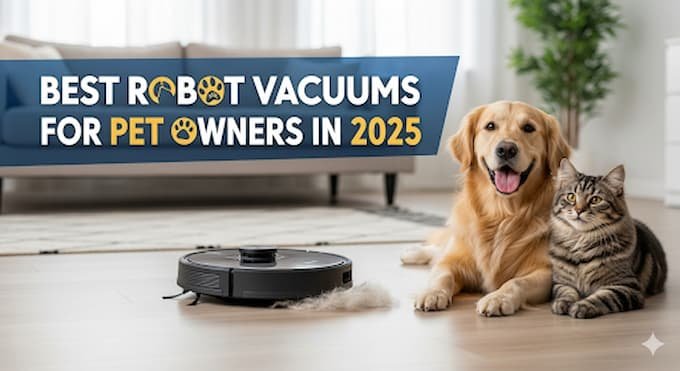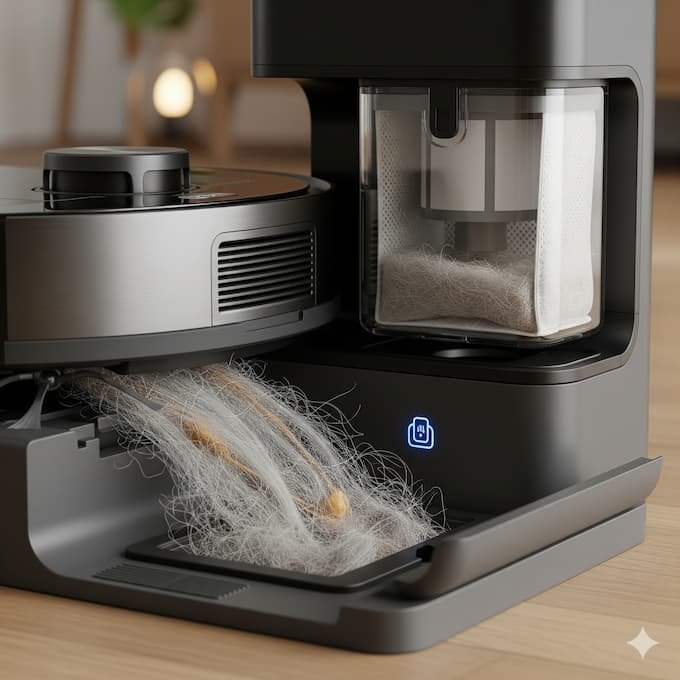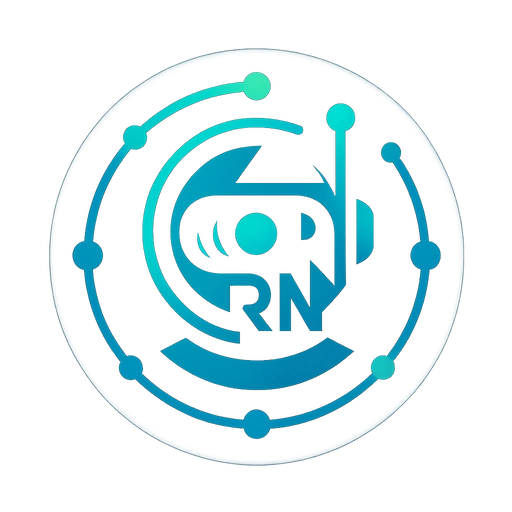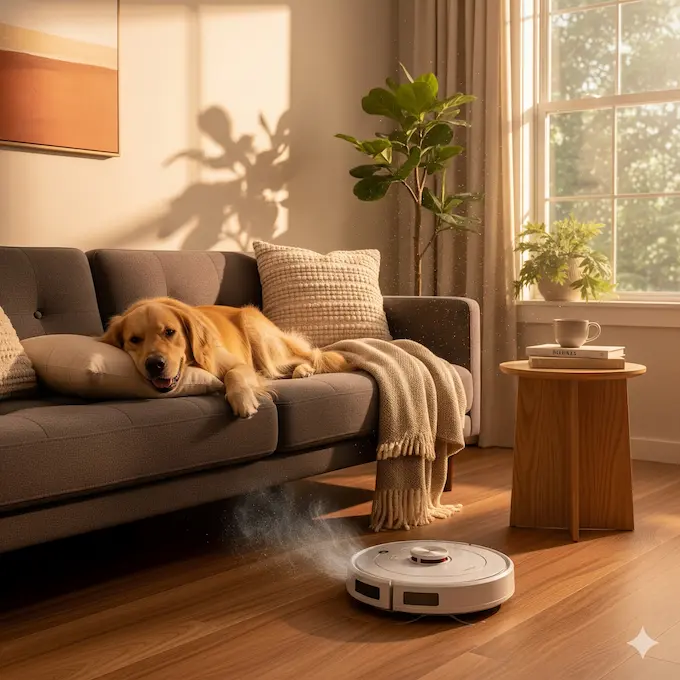Table of Contents
Introduction:
The Ultimate Guide for best vacuum robot for pets
The joy of sharing a home with a furry companion is often accompanied by a perpetual, and at times overwhelming, cleaning challenge to complete this challenge we need Best Robot Vacuums for Pet people are facing a unique set of floorcare realities that extend far beyond general household debris. These include the relentless cycle of shedding, which carpets and rugs seem to absorb with an almost magnetic pull; the invisible threat of pet dander, a potent allergen that can compromise indoor air quality; the muddy paw prints and surprise spills that require a solution beyond mere vacuuming; and the anxiety that comes with leaving an expensive automated device to navigate an environment where pet toys, food bowls, and even unforeseen accidents can pose a threat.
For years, robot vacuums offered a partial solution, reducing the burden of daily sweeping but often falling short on the most difficult tasks. However, the year 2025 marks a definitive maturation of the market. Manufacturers, fueled by a robust residential market growth that is projected to reach a compound annual growth rate of 13.9% between 2024 and 2025, are no longer content with incremental improvements. They are engineering a new class of robots specifically designed to confront these pet-related realities head-on.
This Article is not a simple , It is a deep, data-driven analysis for the discerning consumer. It dissects the foundational technologies that matter most, provides expert, vetted reviews of the leading models, and offers a transparent look at the long-term financial commitment of ownership. The goal is to equip the reader with the knowledge to make a confident investment in a device that is no longer just a gadget, but a true partner in maintaining a clean, healthy, and stress-free home
Foundational Technologies: What Pet Owners Must Look For
Best Robot Vacuums for Pet Features for Homes

The effectiveness of a robot vacuum in a pet-filled home is not determined by its brand name but by its core technological architecture. The following features are non-negotiable for anyone serious about managing pet related messes.
Suction Power: The Force Behind the Clean
Suction power, measured in Pascals (Pa), is a critical metric for pet owners. While standard robot vacuums typically offer suction ratings between 2,000 and 3,000 Pa, this level is often insufficient for lifting stubborn pet hair and dander embedded deep within carpet fibers. The year 2025 has seen an industry-wide acceleration in what can be described as a “suction power arms race,” a direct response to the long-standing problem of deeply lodged pet hair.
Leading mid range and premium models have set a new performance baseline. The Roborock Q5 Max+ delivers a formidable 5,500 Pa, a level considered a must-have for heavy shedding environments. This trend escalates dramatically with flagship models. The Dreame L40 Ultra boasts 11,000 Pa of suction, while the Narwal Freo Z Ultra pushes this even further with a powerful 12,000 Pa. New models from Ecovacs reach an impressive 18,500 Pa , and emerging brands like Mova have unveiled a new market leader in the V50 Ultra, which boasts a staggering 24,000 Pa of suction power. This intense focus on escalating raw power is a direct reflection of manufacturers’ dedication to solving the most fundamental pet-related cleaning problem, transforming a qualitative frustration into a quantitative engineering challenge.
One of the most common frustrations for pet owners is the inevitable hair wrap around a vacuum’s brushroll, a problem that necessitates frequent, messy, and time-consuming manual maintenance. This universal pain point has led manufacturers to implement a new “tangle-free mandate” in modern robot vacuum design.
Traditional bristle brushes are being supplanted by specialized solutions. Many top-rated vacuums now utilize dual counter-rotating rubber brushrolls, a design featured on models like the Roborock Q5 Pro+ and the S8+. These rollers are designed to agitate carpets and pull hair toward the vacuum’s intake without allowing it to wrap around the roller itself. This design has been lauded by pet owners, with one Reddit user who owns a heavy-shedding Newfoundland noting that their Roborock Q8 Max+ with dual rollers significantly reduced the need for manual cleaning. Other brands have developed their own solutions, such as Shark’s brushroll with a “hair cutting blade thing” and Ecovacs’ “ZeroTangle” technology, which uses a combination of V-shaped bristles and comb teeth to actively untangle and guide hair into the bin. The success of these technologies is not just an incremental improvement; it is a foundational shift that directly eliminates the most irritating manual maintenance task for pet owners, fundamentally altering the hands-on nature of robot vacuum ownership.
Intelligent Navigation: Avoiding Pet-related Pitfalls
The ability of a robot vacuum to navigate a home is a crucial factor in its efficiency and reliability. The two primary technologies are LiDAR and AI-powered cameras, often referred to as vSLAM.
- LiDAR (Light Detection and Ranging): This technology uses a raised central puck to emit laser pulses that create a precise, three-dimensional map of a room. LiDAR is exceptionally accurate and operates effectively in low-light conditions, making it ideal for cleaning under furniture or in dimly lit rooms. Its superior precision ensures a methodical, row-by-row cleaning pattern without missing spots.
- AI/Camera (vSLAM): This approach uses a camera and computer vision to visually map a space. While it can identify and recognize objects, it is generally less accurate at measuring distances and requires adequate lighting to function optimally.
- Hybrid Systems: The most advanced models now combine both LiDAR and AI cameras. This fusion allows the robot to leverage the speed and precision of LiDAR for general navigation while using the object recognition capabilities of the camera to identify and react to obstacles in its path.
For pet owners, this advanced navigation is not just about efficiency; it’s about avoiding potential disasters.
The P.O.O.P. Promise and the “Pooptastrophe” Problem
A robot vacuum’s most notorious and feared potential for failure in a pet-filled home is an encounter with solid pet waste. This dreaded scenario, sometimes referred to as a “pooptastrophe,” can ruin the device and spread the mess throughout the home. iRobot has directly addressed this anxiety with a unique brand guarantee: the P.O.O.P. (Pet Owner Official Promise). The Roomba j9+ and j7+ models are equipped with “PrecisionVision Navigation,” an AI-powered camera system that identifies and actively avoids pet waste. If the device fails to avoid solid waste within a year of purchase, iRobot promises to replace the robot for free. This guarantee is not merely a feature; it is a profound brand commitment that recognizes and addresses a major emotional and financial risk for the pet owner. It shows how manufacturers are now building trust by directly confronting the most high-stakes, pet-specific cleaning fears.
The Top-Tier Contenders: Our Expert-Vetted Recommendations for 2025
Choosing the best robot vacuum depends on a pet owner’s specific circumstances, including floor type, the volume of shedding, and budget. The following models represent the pinnacle of pet-focused cleaning technology in 2025, each excelling in a particular category.
Key Specifications & Ratings of Top Robot Vacuums for Pet Owners 2025
“Comparison table of the best robot vacuums for pet hair in 2025 with suction power, pet features, navigation, and self-emptying capacity.”
| Model | Suction Power | Self-Emptying Capacity | Pet-Specific Features | Navigation Technology | Tested Battery Life |
|---|---|---|---|---|---|
| Dreame L40 Ultra | 11,000 Pa | 3.2 L (dock) | All-around pet hair pickup, excellent mopping | LiDAR & AI | Not specified |
| iRobot Roomba j9+ | 10x suction vs. 694 | 60 days of debris | P.O.O.P. Promise, PrecisionVision Navigation | AI/Camera | 113 min |
| Roborock Q5 Pro+ | 5,500 Pa | 2.5 L (dock) | Dual rubber brushrolls, large dustbins | LiDAR | 240 min (hard floors) |
| Roborock S8+ | 6,000 Pa | 7 weeks of debris | Dual rubber brushes, carpet boost | LiDAR | 180 min |
| Ecovacs Deebot X8 Pro Omni | 18,000 Pa | Not specified | Tangle-free brush, roller mop | LiDAR & AI | 134 min |
| Narwal Freo Z Ultra | 12,000 Pa | 2.5 L (dock) | Zero-tangle brush, quiet operation | Dual AI cameras | Not specified |
Best Overall: Dreame L40 Ultra
The Dreame L40 Ultra has emerged as the best overall robot vacuum for pet owners, earning top marks from professional testers for its comprehensive performance. With a remarkable 11,000 Pa of suction, this model is engineered to handle a significant volume of pet hair and a variety of debris. Beyond its raw power, it is a truly hands-off cleaning ecosystem. Its dock not only empties the robot’s dustbin but also manages the mopping function, a feature particularly useful for tackling messes from muddy paws. The L40 Ultra’s all-in-one approach to vacuuming and mopping, combined with its high suction and effective navigation, makes it a premium, one-stop solution for the complex demands of a pet-filled household. This represents a trend where the value proposition is no longer just a vacuum but a fully automated cleaning service.
Best for Pet Accidents & Obstacle Avoidance: iRobot Roomba j9+
The iRobot Roomba j9+ is specifically designed for a home with pets, featuring more pet-centric features than any other iRobot model. Its “PrecisionVision Navigation” system uses a camera to identify and steer clear of common household obstacles such as shoes, cords, pet bowls, toys, and, most critically, pet waste. The iRobot brand has built its reputation on this core technology, and its P.O.O.P. (Pet Owner Official Promise) provides a unique level of security for the user. This is an indication of a brand specializing in pet-centric fears, addressing a specific, high-stakes anxiety with a direct and financially-backed promise. While its suction power is not as high as some competitors, it is designed to expertly navigate and clean around clutter and messes, which is a major convenience for pet owners who cannot “pre-clean” their homes before every cycle.
Best for Deep Carpet Cleaning: Roborock S8+ and Roborock Q5 Pro+
For homes with heavy shedding pets and significant carpeted areas, the Roborock S8+ and Roborock Q5 Pro+ are exceptional choices. The Roborock S8+ features dual rubber brushes and 6,000 Pa of suction power, which in testing proved highly effective at agitating and lifting pet hair and debris from carpets without getting tangled. A customer with a Great Pyrenees noted that the S8+ reduced their manual vacuuming from daily to weekly. The Roborock Q5 Pro+ is a more budget-friendly option that still excels at this task, with 5,000 Pa of suction and dual rollers designed to handle heavy shedding. This performance on carpets demonstrates a significant evolution in the technology. Previously, traditional vacuums were often considered superior for deep carpet cleaning, but the success of Roborock’s dual-roller design shows that robot vacuums are now a legitimate and effective solution for even the most challenging carpet cleaning scenarios. This is a clear manifestation of what can be described as the “rubber roller revolution” on carpets, a focused engineering response to a critical cleaning need.
Best All-in-One Robot & Mop Combo: Ecovacs Deebot X8 Pro Omni
The increasing demand for devices that can handle both vacuuming and mopping has led to a new class of “hybrid master” devices. The Ecovacs Deebot X8 Pro Omni is a leading example, providing a comprehensive solution to the “muddy paw” and spill messes common in pet homes. With a potent 18,000 Pa of suction and an effective roller mop, it performs well on both vacuuming pet hair and mopping up spills. The comprehensive self-maintenance dock handles not only dustbin emptying but also washes and dries the mop pads, preventing cross-contamination and odors. Similarly, the Narwal Freo Z Ultra offers a premium mopping experience with 12,000 Pa of suction and a base that washes its mop pads with 167°F hot water. These technologies show that the market is evolving to solve secondary pet-related messes, providing a complete, hands-off solution for a wider range of floorcare challenges.
Best Value Pick
Not all pet owners require a premium, feature-rich device. For those prioritizing core functionality and a more accessible price point, the market has matured to offer excellent value options. The Roborock Q5 Pro+ is one such model, combining a powerful vacuuming experience with an auto-empty dock at a more accessible price. The iRobot Roomba 694, while a simpler model without self-emptying or advanced navigation, is praised by pet owners for its reliable ability to pick up pet hair, especially on hard floors. These models serve as an ideal “entry point” into the world of autonomous cleaning. The compromise for the lower cost is typically in features like advanced obstacle avoidance, larger dustbins, or sophisticated app control, but for many users, the fundamental benefit of automated pet hair pickup is well worth it.
The True Cost of Convenience: Long-Term Ownership
The upfront price of a robot vacuum is only one part of the total cost of ownership. For pet owners, whose homes generate a higher volume of debris, the recurring cost of replacement parts and consumables is a critical factor in the long-term investment.
| Item | Estimated Cost |
|---|---|
| Filters (3-pack) | $10–$37 |
| Side Brushes (2-pack) | $10–$16 |
| Main Brushes (1-2 per year) | $15–$46 |
| Self-Empty Dust Bags (3-pack) | $20–$32 |
| Mopping Pads | $10–$50 |
Estimated Annual Maintenance & Ownership Costs
The ongoing maintenance of a robot vacuum primarily involves replacing its consumable parts. This includes filters, side brushes, and main brushrolls, all of which will degrade over time due to the constant friction and debris from pet hair. For models with self-emptying docks, the cost of replacement dust bags is a key consideration, with 3-packs typically costing between $20 and $32. For those with mopping capabilities, replacement mop pads and cleaning solutions are an additional recurring expense. The total annual cost of these consumables can range from a modest sum for entry-level models to a more significant figure for premium devices with multiple features.
However, it is important to contextualize this cost against the value provided. According to one user’s estimate, a robot vacuum can save over 100 hours of human cleaning time per year, offsetting its maintenance cost with significant savings in effort and time. While batteries will eventually degrade, the process is often not severe within the first three and a half years of ownership, and many brands make it easy to find spare parts. Therefore, the long-term cost is less of a barrier and more of a predictable, small fee for the immense convenience and hands-off cleaning experience that these devices provide.
The Future of Robot Vacuums: 2025 Trends for Pet Owners
The innovations of 2025 are not just about more powerful motors or smarter software; they are about fundamentally re-engineering the robot’s role in the home. The ultimate goal of robot vacuum innovation is a “zero pre-clean” experience—a state where the user no longer has to tidy up the floor before sending the robot out to clean. The following emerging technologies showcased at tech events like CES and IFA 2025 represent the next logical steps toward this reality.
Robotic Arms and Stair-Climbing
The most futuristic innovation to appear in 2025 is the integration of robotic arms. Roborock’s flagship Saros Z70 features an “OmniGrip” arm designed to pick up small objects like socks, pet toys, or stray cables that would otherwise obstruct the cleaning path. Dreame has also presented a prototype with a similar mechanical arm, signaling a broader industry move toward devices that can actively manage their environment.
Another groundbreaking development is the ability to navigate physical barriers. The Dreame X50 Ultra features a “ProLeap System” with robotic legs that can lift the device to climb short steps or thresholds up to 60 mm. These technologies show that manufacturers are not just improving the cleaning process but are building devices with superior mobility and problem-solving capabilities, directly addressing the pain point of having to rescue a stuck or tangled robot.
Multi-Purpose Platforms and Smarter AI
The SwitchBot K20+ hints at a future where the robot vacuum is no longer a single-function device. It incorporates a modular “Fusion Platform” that can support various attachments, from air purifiers to security cameras, turning the cleaning bot into a multi-purpose home robot. This trend is bolstered by advancements in AI, with brands like Ecovacs introducing improved voice assistants such as YIKO-GPT, which is supported by a large language model. This development enables a more natural and fluid human-AI interaction, allowing the user to give complex commands and routines with greater ease and accuracy.
These innovations are not isolated; they are part of a connected, forward-looking strategy. They show that the industry is focused on eliminating the last remaining barriers to true cleaning autonomy. As the residential robot vacuum market continues its robust growth trajectory, these advancements will transition from futuristic prototypes to standard, must-have features, reshaping what consumers expect from their automated cleaning companions.

Conclusion:
Finding Your Perfect Pet-Cleaning Companion
The landscape of robot vacuums in 2025 has been dramatically reshaped by a new focus on solving the specific, long-standing problems faced by pet owners. The analysis of market trends and technological innovations points to a clear conclusion: there has never been a better time to invest in a device that can genuinely handle the perpetual challenges of a pet-filled home.
The decision of which model to purchase ultimately depends on a user’s specific priorities:
- For the Power User: A pet owner with significant shedding and a mix of carpets and hard floors should prioritize models with industry-leading suction power and an effective dual-roller brush system, such as the Dreame L40 Ultra or a Roborock S8+.
- For the Anxious Owner: For those whose primary concern is the unpredictable nature of pet messes, the iRobot Roomba j9+ offers unparalleled peace of mind through its advanced object avoidance and the unique P.O.O.P. promise.
- For the All-in-One Solution: Homeowners with both shedding pets and potential spills will find the most value in a hybrid vacuum and mop, especially models with a self-maintaining dock and hot water mopping, such as the Ecovacs Deebot X8 Pro Omni or the Narwal Freo Z Ultra.
- For the Budget-Conscious: Even with a limited budget, it is possible to acquire a highly effective device. The key is to prioritize a model with strong core suction and a robust brush system, accepting the trade-off of a less automated or hands-off experience.
Ultimately, the long-term value of a quality robot vacuum for a pet owner is measured not just in its performance, but in the hours of labor it saves and the peace of mind it provides. In 2025, these devices are no longer just cleaning machines; they are a critical part of a modern, stress-free home management strategy.
What is the best self-emptying robot vacuum for pet hair?
The iRobot Roomba j9+ and Dreame L40 Ultra are top picks. Both automatically empty into a larger dock, meaning you can go weeks without touching a dustbin. The Roomba j9+ also comes with the P.O.O.P. Promise, guaranteeing it will avoid pet waste.
What is the best robot vacuum and mop combo for pet owners?
The Ecovacs Deebot X8 Pro Omni is the leading all-in-one solution. It doesn’t just vacuum pet hair, it also scrubs muddy paw prints with roller mops. Its dock empties dust, washes mop pads, and even dries them to prevent odors.
What is the best robot vacuum for pet hair and carpet?
If you’ve got wall-to-wall carpet and a shedding pet, the Roborock S8+ is your friend. Its dual rubber rollers agitate carpet fibers without tangling, and 6,000 Pa suction ensures embedded fur is lifted out. For a slightly more affordable option, the Roborock Q5 Pro+ delivers excellent carpet performance at a lower price
What’s the best robot vacuum for pet hair on hardwood floors?
On hard floors, suction power matters less than brush design. The Wyze Robot Vacuum is a budget-friendly option for smaller homes with hardwood. If you want premium performance, the Roborock S8 MaxV Ultra handles both fur and dust on wood surfaces exceptionally well, thanks to dual rollers and smart navigation.
Does the Roomba j9+ empty itself?
Yes. The Roomba j9+ has a Clean Base station that can hold up to 60 days of debris. This means you won’t need to empty it manually for weeks at a time, even in a multi-pet household.
What’s a disadvantage of using a Roomba?
The main downside is price. Premium Roombas like the j9+ can be significantly more expensive than competitors with similar suction. Also, while they’re excellent at avoiding waste and clutter, they still require ongoing maintenance (brush and filter replacements).
What is the best overall robot vacuum?
The Ecovacs Deebot T30S Combo remains in our top spot on the best robot vacuums list, despite stiffening competition.
Sources:
https://www.techradar.com/best/best-robot-vacuum-for-pet-hair
https://www.forbes.com/sites/forbes-personal-shopper/article/best-robot-vacuum-for-pet-hair
https://www.ecovacs.com/us/blog/hepa-filter-vacuum
https://www.cnet.com/home/kitchen-and-household/best-robot-vacuum


